Feb 11, 2022 | coins, nickels
Instead of posting the next article in my exonumia tour of New York City, I decided to show you that I am still collecting United States legal tender coins.
Two of the most important coins of the circulated Liberty Head “V” Nickels are the 1912-D and 1912-S, the only two Liberty Head Nickels not struck in Philadelphia. Even though the restriction to strike nickels in Philadelphia was lifted in 1906, many other political factors prevented the U.S. Mint from striking them in Denver and San Francisco until 1912.
Delays in obtaining planchets and preparing dies prevented the San Francisco Mint from striking nickels until Christmas Eve in 1912. After four business days at the end of the year, the San Francisco Mint struck only 238,000 coins, the lowest of the series and any business strike nickel.
-
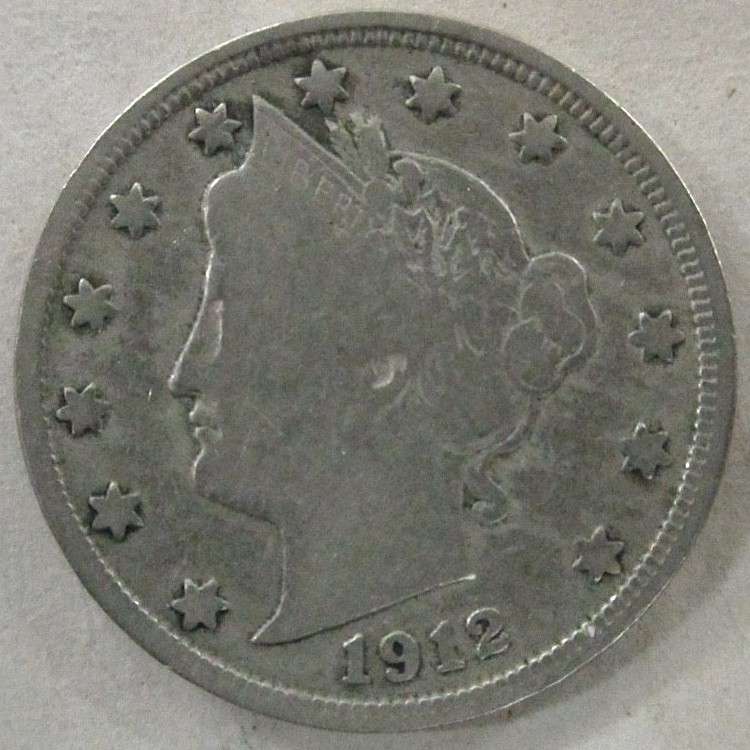
-
1912-S Liberty Head Nickel
-
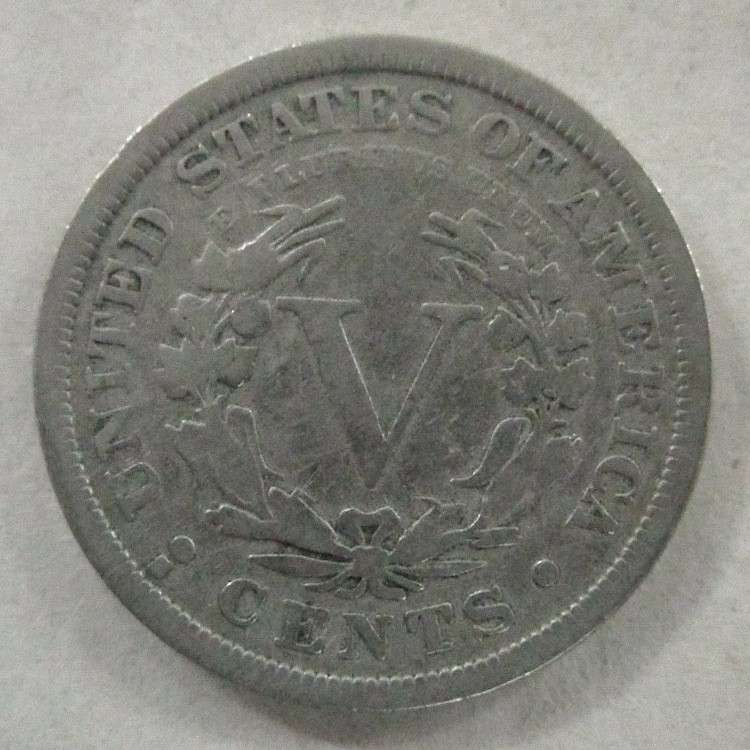
-
Reverse of the 1912-S Liberty Head Nickel
-

-
The “S” Mintmark of the 1912-S Liberty Head Nickel.
When you collect a series, some people say first to find the key and semi-key date coins. The keys are the most difficult to find and the most expensive of the series. If you have a limited budget but want to have fun, you might as well hunt for all of the coins in the series. When you have more money to spend, go after the higher-priced coins.
Another strategy is to collect a series in a grade that is challenging. For the Liberty Head Nickels, you can collect the series in uncirculated and lower grades are easier than most people think. The problem is that the soft nickel wears easily, and most of the examples we see are in lower grades. A dealer once told me that finding a mint state (uncirculated) Liberty Head Nickel is easier than finding one in Very Fine or Extra Fine condition.
But when the opportunity comes to find a key date coin priced less than the price guides, you do what it takes to buy the coin. The 1912-S Liberty Head Nickel is now part of my collection, probably grade VG-10. It was a nicely struck coin with an almost full “LIBERTY” visible in the headband. The “S” mintmark is visible on the reverse but looks a little like a blob.
-
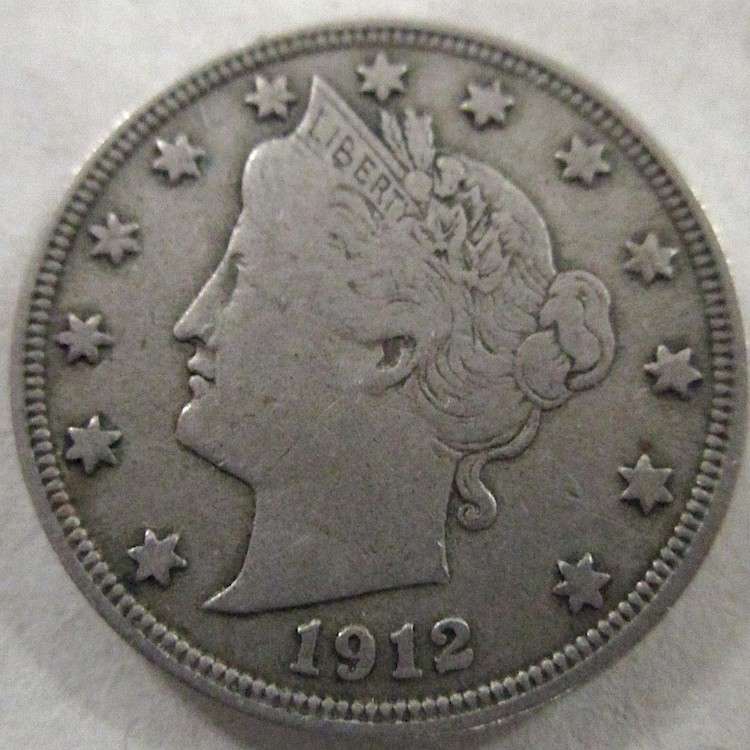
-
1912-D Liberty Head Nickel
-
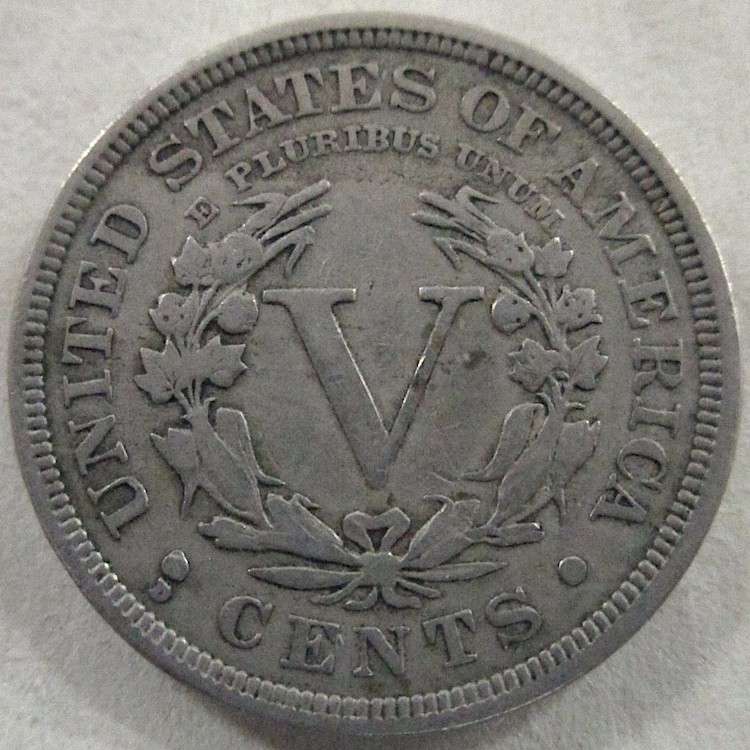
-
1912-D Liberty Head Nickel reverse
-
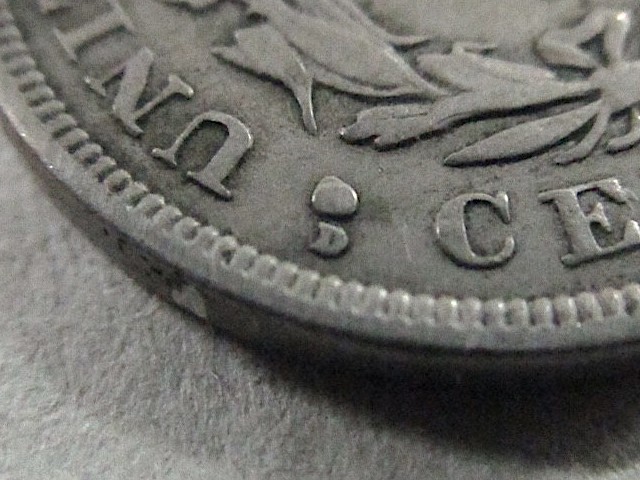
-
The “D” Mintmark on the reverse of the 1912-D Liberty Head Nickel
The 1912-D Liberty Head Nickel I purchased at the same time is closer to F-12 condition, and it sports a full “LIBERTY” in the headband and a strong “D” mintmark on the reverse.
I started collecting Liberty Head “V” Nickels in 2009, and it is now complete. I may try to upgrade a few coins, but the sense of accomplishment now has me thinking about my next challenge.
Mar 16, 2020 | coins, news, nickels
Following Saturday’s article, an article appeared in my newsfeed with tips on how to start building a collection of Buffalo Nickels.
CNN interviewed noted numismatist Charles Morgan. The article is a good synopsis of collecting Buffalo Nickels.
Buffalo nickels are a favorite of a lot of people. Designed by James Earle Fraser, the Buffalo Nickel was struck by the U.S. Mint from 1913 to 1987. The obverse of the coin features a Native American that Fraser said was a composite design of three chiefs, and the reverse is a buffalo that Fraser said was modeled after Black Diamond, an American bison he found at the Bronx Zoo. Both claims by Fraser have been controversial since several American Indian Chiefs claimed to have been Fraser’s model, and Black Diamond lived at the Central Park Zoo. In either case, it is a beautiful coin and an excellent entry to collecting.
Buffalo nickels are very available coins with a few exceptions. Beautiful examples with full dates and at least three-quarters of the buffalo’s horn still visible are available at reasonable prices.
For someone starting a Buffalo nickel collection, you might want to consider starting with a date and type set. Going this route would spare the beginning collector from trying to find the Type 2 1913-D and 1913-S coins, which can be expensive.
If you complete the goal of the date and type set, then try to fill in the rest of the coins to create the full date and mintmark set.
Another idea is to use the Buffalo nickel as the basis to collect other coins with buffaloes as part of the design. In 2011, I presented a Herd of Buffaloes type collection. Maybe it can be something to do while riding out the current situation.
Maybe, if we can attract new collectors using an article from CNN, we can encourage them to write more.
And now the news…

March 6, 2020
The five extremely rare Islamic coins dating from the 7th century AD Image Credit: Dubai: As a UAE exhibition – Coins of Islam: History Revealed – with a display of 300 coins is proving to be a big draw at the Sheikh Zayed Grand Mosque Centre in Abu Dhabi, five rare coins are making big news globally because they offer a historic narrative of Islamic coinage, dating back to the 7th century or the dawn of Hijri (Islamic calendar).

→ Read more at
gulfnews.com

March 10, 2020
Some of the coins and pins made by Brad Brown, owner of B2 Promotions. HERMITAGE – When people ask Brad Brown what he does for a living, he isn’t sure what to tell them.

→ Read more at
meadvilletribune.com

March 11, 2020
A rare 1,300- year-old coin featuring the face of an unknown Saxon King sells for ₤48,000 after the proprietor invested 3 years attempting to verify its historic relevance.

→ Read more at
theunionjournal.com

March 14, 2020
Written by Forrest Brown, CNN Whether an entry point for budding neophytes or the domain of studied numismatists, buffalo nickels hold a fascinating place in the world of coin collecting. For the uninitiated, buffalo nickels are copper-nickel 5-cent pieces produced by the US Mint in the first half of the 20th century.

→ Read more at
cnn.com
Jul 18, 2018 | coins, foreign, nickels
This week’s LOOK BACK is from June 15, 2006. After a club meeting, I was inspired by two of the presentations.
Local coin clubs are a place you can regularly go to talk about coins and numismatics with like-minded collectors. If you have not attended a meeting you should find time to go. You might find that there is a learning experience that can inspire you in your collecting endeavors. One of the reasons I try to ensure I make it to the monthly meeting of my local coin club is because I seem to leave every meeting with an appreciation for something different about the hobby.
Our club encourages members to bring in their monthly finds. A numismatic show-and-tell. This week, Jerry Grzenda, a collector of many different types of coins and a serial exhibitor, showed his collection representing the last century of Iran. Jerry’s presentation included a history of Iran as seen through its coinage. It was a great learning experience and the coins were beautiful. There is something about the style of the Persian language that is intriguing and adds to the aesthetic of the coins.
Another highlight of the meeting was the presentation by Ron Brais about Hobo Nickels. While I have heard about Hobo Nickels, all I knew about them was what I learned in passing. In listening to Ron talk, I learned that the original Hobo Nickels were created between 1913 and 1935 using only Buffalo Nickels because the design had large figures on both sides that could be used as the basis of the design. The copper-nickel coins are also softer than others allowing them to be more easily carved. These elements allowed the carver to make just about any design and usually did. Designs were as varied as the artists who carved them. Hoboes would use the carved nickels to trade for food, shelter, or other favors during their travels.
The most famous Hobo Nickel artist was George Washington “Bo” Hughes. Bo ran away from home at a young age and was befriended by a hobo identified as Bert. After a train yard scuffle, Bert took Bo under his wings, protected him from the tramps and bums and taught Bo how to carve realistic images into the Buffalo nickel. For many years, Bo would ride the rails and carve nickels living the life of the hobo as he looked for work to survive. Bo’s work on Hobo Nickels allowed him to eventually get a job as a craftsman. It lasted until 1957 when he cut his left hand while carving a nickel. At that time Hobo Nickels were no longer popular and Bo just faded away. He died in 1982.
The life and history of George Washington “Bo” Hughes has been immortalized in the book Hobo Nickels by Delma K. Romines (out of print).
Today, the Original Hobo Nickel Society has a number of artist members that are carving images into Buffalo and Jefferson nickels to keep the art alive. Some of the designs are ingenious and beautiful while others are copies of carving on older coins. Modern nickels are made using modern tools that allow the carving to look much cleaner than their older examples. The old methods and tools were not able to make clean lines but it gave them a character that cannot be matched. To see the work of modern Hobo Nickel artists, follow @Hobo_Nickel_Soc on Twitter and try to resist not buying them!
The example of a Bo Hughes carved nickel displayed as part of the presentation beautiful in its design and execution. The care and craftsmanship that went into carving that coin was evident. Hobo Nickels can sell from $200-$1500 depending on condition and the artist. Coins by Bo Hughes are worth more than others.
Nov 24, 2017 | cents, coins, dollar, fun, halves, nickels, state quarters
 What would it take to put together a modern type set?
What would it take to put together a modern type set?
How would you define a modern type set?
This is the summary of the email conversation I have been having with someone looking for an interesting challenge to work on with his children.
For new readers and those new to numismatics, a type set is one coin of every type regardless of date or mintmark. Although some coins have one-year types, like the 50 State Quarters, there are others where one coin will represent an entire series, like the Roosevelt Dime.
While there are a lot of interesting coins types we focused on modern coins. Modern coins are those struck since 1965 when coins went from silver to copper-nickel except for the Kennedy half-dollar that was made of 40-percent silver through 1970. To budding young numismatists, modern coins are all they know.
In fact, all they know is that the quarter has a constantly changing reverse and they have seen differences in the Lincoln cent and the Jefferson nickel. They did not go through the fiasco of the Susan B. Anthony dollar or marvel at the first circulating commemoratives of the modern era: the dual-dated bicentennial coins. They were not around to search boxes of Cheerios for the new Sacagawea dollar coin or the millennial cent.
-
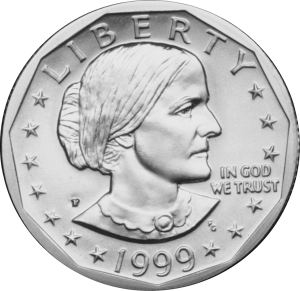
-
Obverse of the Susan B. Anthony Dollar
-

-
The 2000 Cheerios Dollar
Modern coins do not get the same love as some of the classics. Aside from not containing silver, there have been controversies over designs (see the “spaghetti hair” that George Washington was sporting on the 50 State Quarters) and how the relief on coins has been lowered by the U.S. Mint in an attempt to extend die life.
Some not-so-great designs
-

-
Obverse of the 50 State Quarters with Washington’s spaghetti hair
-
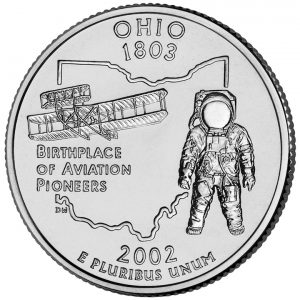
-
2002 Ohio Quarter with the hanging astronaut
-
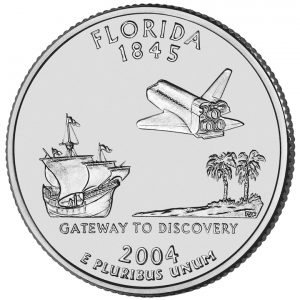
-
2004 Florida Quarter with a jumble of stuff
Although people love the classic designs two of my favorite designs of the modern era is the Drummer Boy reverse on the Bicentennial quarter and the Thomas Jefferson portrait on the obverse of the 2005 Westward Journey nickels. And even though I have not written much about them, there are some fantastic designs in the America the Beautiful Quarters series. A few that you may want to take a second look at include 2017 Ellis Island, 2017 George Rogers Clark National Historic Park, 2016 Shawnee National Forest, and the 2015 Blue Ridge Parkway quarters just to name a few.
A few of the great America the Beautiful Quaters designs
-
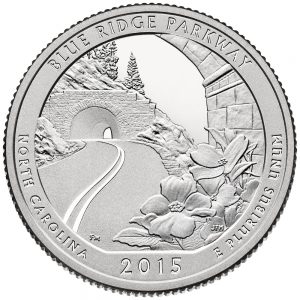
-
2015 Blue Ridge Parkway – North Carolina
-

-
2016 Shawnee National Forest – Illinois
-

-
2017 Ellis Island – New Jersey
-
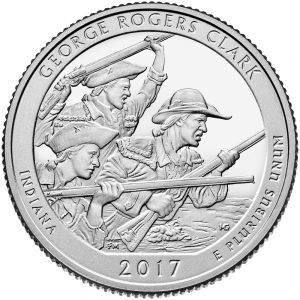
-
2017 George Rogers Clark National Park – Indiana
Sitting with a Red Book, I started to list the coin types that would make up a modern type set. If we limited the set to circulating coins (e.g., not including half-dollars and one-dollar coins) that can be found in pocket change, there would be 128 coins with a face value of $28.97.
| Type |
No. in Series |
Face Value |
Series Value |
| Lincoln Memorial Cents |
2 |
0.01 |
0.02 |
| Lincoln Bicentennial Cents |
4 |
0.01 |
0.04 |
| Lincoln Shield Censt |
1 |
0.01 |
0.01 |
| pre-2004 Jefferson Nickels |
1 |
0.05 |
0.05 |
| Westward Journey Nickels |
4 |
0.05 |
0.20 |
| Return to Monticello Nickels |
1 |
0.05 |
0.05 |
| Roosevelt Dimes |
1 |
0.10 |
0.10 |
| Washington Quarters |
1 |
0.25 |
0.25 |
| Bicentennial Quarters |
1 |
0.25 |
0.25 |
| 50 State Quarters |
50 |
0.25 |
12.50 |
| D.C. and U.S. Territories Quarters |
6 |
0.25 |
1.50 |
| America the Beautiful Quarters |
56 |
0.25 |
14.00 |
| Total |
128 |
1.53 |
28.97 |
The above table does take into consideration the entire 56 Amercia the Beautiful Quarters series including future issues. The kids have to understand the concept of future issues and maintain space for these coins in their album.
Starting the set with pocket change allows the kids to get used to the concept of looking at the coins to understand what they are looking for. To help with their search each child was given a Red Book and two apps on their iPads: PCGS CoinFacts and PCGS Photograde. They can use the Red Book as a handy off-line reference but use PCGS CoinFacts to learn more when they have access. Photograde is very useful to help them assess the condition of the coins.
While collectors have a basic understanding of coin grading, getting it right can be difficult. These kids were given a basic lesson on things to look for when trying to assess the condition of the coins they find. It will be interesting to see how they interpret this information.
Once we covered coins that can readily be found in circulation, we then discussed the other business strikes that are usually not found in ordinary pocket change.
After an interesting discussion, it was decided to make those a separate collection.
As a separate collection, this will give the kids an opportunity to go to dealers and coin shows to allow the kids to learn about buying coins in this environment. They will learn how to talk with a dealer, gain experience negotiating, and do some comparison shopping. It will let them get the experience and see different coins but maintain a collection discipline that will allow them to learn to collect on a budget.
What are the modern type coins that do not see a lot of circulation? Once again, I sat with the Red Book and came up with the following list:
| Type |
No. in Series |
Face Value |
Series Value |
| Kennedy Half Dollars |
1 |
0.50 |
0.50 |
| Bicentennial Kennedy Half Dollar |
1 |
0.50 |
0.50 |
| Eisenhower Dollars |
1 |
1.00 |
1.00 |
| Bicentennial Eisenhower Dollars |
2 |
1.00 |
2.00 |
| Susan B. Anthony Dollars |
1 |
1.00 |
1.00 |
| Sacagawea Dollars |
1 |
1.00 |
1.00 |
| Native American Dollars |
11 |
1.00 |
11.00 |
| Presidential Dollars |
39 |
1.00 |
39.00 |
To complete the task, I came up with a checklist for all of the modern coins in two formats. One is a printed version that they could keep in their pocket as they go about their day. The other is a spreadsheet that can act as an official record. The paper version is a very basic PDF file that can be used to write notes. The spreadsheet offers more information. It also allows them to come up with their own catalogue.
Both files are attached for you to use (see the Creative Commons Attribution-NonCommercial-ShareAlike 4.0 International License for text of the permissions granted with this release).
It will be interesting to see what these kids do!
Checklists
Modern Coinage Type Set Checklist
Modern Coin Type Set Detailed Checklist
Aug 28, 2016 | coins, nickels, pocket change
During the busy week, I will empty my pocket of change and place it on my dresser. When it gets too piled up I will see if there is anything worth a further look before dumping them into a nearby container. After a year, the container is emptied and the proceeds go to charity. But that is after I search for anything interesting.
When I pay by cash, I pay using currency and pocket all of the change so that I can see what I find. Most of the time I am able to pick out items that require further examination when the change is handed to me. Those coins are put in another pocket for later. This week there was little time. Projects have to be completed and it is almost time for football season. No time to waste.
After four days, I did not think there would be much until the single layer started to grow higher. It was time to scoop them into my jar when I started to nice that a nickel did not look right on first glance. It looked worn but it was a nickel. After looking closer the date said 1902. It is a fairly beaten up 1902 Liberty Head “V” Nickel with scratches and what looks like was once graffiti scratched into the reverse. This coin is so bad off that I do not think the third-party grading services would encapsulate it even for a low-grade registry set!
-

-
1902 Liberty Head V Nickel from a pocket change find
-
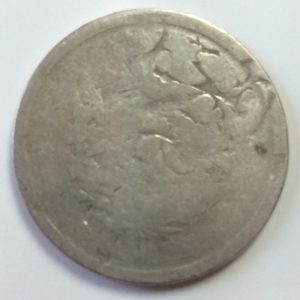
-
1902 Liberty Head V Nickel (reverse) from a pocket change find
This nickel might be the oldest coin I have found in circulation that wasn’t copper.
My next find was interesting because I figured it out before looking closely. Of all the Jefferson nickels, the easiest ones to pick out are the wartime silver nickels. Wartime nickels have a different colored toning than the regular copper-nickel alloy. These coins do not contain any nickel. They are made of .350 silver, .560 copper, and .090 manganese. Without the nickel to keep some semblance of shine the wartime nickels will tone to a distinctive dark silvery gray. If graded G-4 the coin is worth about $1.20 which is not bad considering its silver value is $1.04!
-
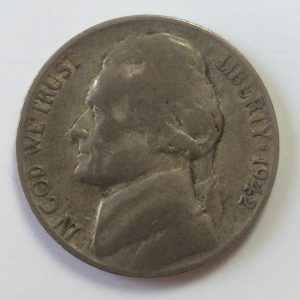
-
A 1942-P Jefferson Wartime Nickel from a pocket change find
-
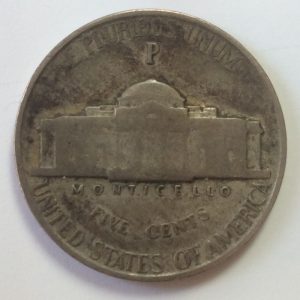
-
Reverse of 1942-P Jefferson Wartime Nickel from a pocket change find
The final find was also easy to identify even before a more careful look. Peaking out from under another coin was the clear sign of an acid date Buffalo nickel. An acid date Buffalo nickel is a coin that had its date restored using a chemical acid, although in this case it looks like the date was worn down after the acid treatment. The distinctive mark left by the chemical can be seen even though the date has worn away again.
-
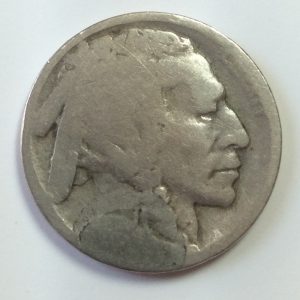
-
A dateless Buffalo Nickel with acid stain from a pocket change find
-
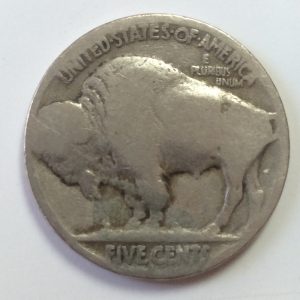
-
Reverse of dateless Buffalo Nickel from a pocket change find
Other than the nickels I continue to find wheat-back cents. I seem to average one per week. This past week I found four with the oldest being a fairly common 1919 cent that looks like it has been well used and cleaned.
-

-
A 1919 Lincoln Cent from a pocket change find
-

-
A 1919 Lincoln Cent (reverse) from a pocket change find
May 16, 2016 | coins, commentary, nickels, poll
 After reporting about the petition to return the Buffalo nickel to circulation, I thought I would ask my readers. Since I have not updated the polls for a while, I thought this was a good topic to begin this week.
After reporting about the petition to return the Buffalo nickel to circulation, I thought I would ask my readers. Since I have not updated the polls for a while, I thought this was a good topic to begin this week.
While I love the design by James Earle Fraser and have starting hoarding Buffalo nickels during my estate finds, I am not sure that this is a design that would work on today’s nickel. Collectors of Buffalo nickels can tell you that while a great design the elements do not wear well especially on critical high points, such as the buffalo’s horn.
Possibly a better idea is to bring back the design of the 2005 Westward Journey American Bison nickel. Aside from having a better portrait of President Thomas Jefferson than the one currently in use, the bison on the reverse appears to work better on modern coins. Maybe the bison can be given a new look, but it would be a better version for today’s market.
-

-

-
2005 Westward Journey Nickel Reverse
What do you think?

Loading ...
Westward Journey nickel imaged courtesy of the U.S. Mint.
May 12, 2016 | celebration, coins, nickels, video
If you missed the news, a few days ago President Barak Obama signed the National Bison Legacy Act (Pub. L. 114-152) that names the “North American Bison” the national mammal. The bison does not replace the Bald Eagle as the national animal or the national emblem.
The bison is an iconic animal unique to North America. Discovered by the European settlers as the country expanded west, the bison was significant to the economic and spiritual lives of the native tribes throughout the Great Plains areas.

Photo from the 1870s of a pile of American bison skulls waiting to be ground for fertilizer.
Although conservation efforts began in the late 19th century, a bison population that used to number in the millions the 2012 Department of Agriculture census said that there were 162,110 heads. Up until the last 50 years, we have done a bad job of taking care of this national resource, now national treasure.
When numismatist thinks of the American Bison, the thought turns to the Indian Head “ Buffalo” Nickel designed by James Earle Fraser. Fraser, a student of Augustus Saint-Gaudens, continued the path of Theodore Roosevelt’s “pet crime” to design a coin that screams America.
The reverse of the coin is an American Bison that we erroneous call a buffalo. According to legend, Black Diamond was Fraser’s model for the reverse of the Buffalo nickel. Black Diamond was a North American bison that was living in the Central Park Zoo. He was donated to the zoo by Barnum and Bailey and lived his life there until he was auctioned in 1915 to a game and poultry dealer who was later sold as steaks for $2 a pound.
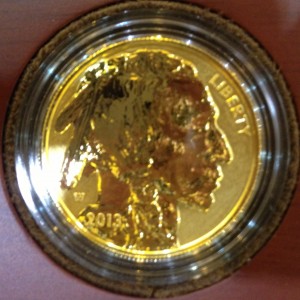
2013-W American Buffalo gold reverse proof obverse
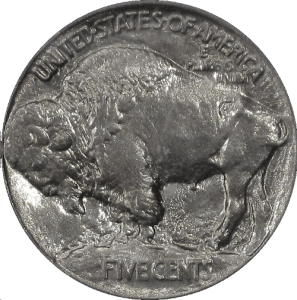
1913 Buffalo Nickel Type 1 Reverse
When asked about the model for the coin, Fraser said it was Black Diamond and found him in the Bronx Zoo. At one time Fraser was not sure of the name of the animal but insisted his influence was at the Bronx Zoo. Black Diamond was never at the Bronx Zoo. But like the story of who was the model for the Indian on the obverse, why should facts spoil a good story!
With the signing of the National Bison Legacy Act there are groups that wants to bring back the Buffalo nickel. Someone started a petition at the online petition website Change.org to convince the U.S. Mint to return to bring back the buffalo nickel.
Even though the U.S. Mint is the wrong agency to address this petition to since it would require an act of congress, the Fraser Buffalo design is still used on the 24-karat gold bullion coin. In fact, not counting varieties, mintmarks and strike types, the bison has appeared on eight different coins and one Legal Tender Note. If you want to put together a nice type set, it would require 22 different coins and the 1901 $10 Legal Tender Note (see “Collecting a Herd of Buffaloes” for this discussion).
I do not know if returning the Buffalo nickel is a good idea. While it was an iconic design, it was one that saw considerable wearing while in circulation. If someone wants to bring the buffalo back to United States coins, maybe we could consider the 2005 Westward Journey nickel with the American Bison reverse. It also has a better portrait of Thomas Jefferson than is currently used.
If you would like to virtually sign the partition, visit Change.org and register your vote.
The Washington Post produced an interesting video with facts about the bison. If you want to see the video without visiting the Post’s website, you can watch it here:
Bison images and the Type 1 Buffalo nickel reverse courtesy of Wikipedia.
Aug 9, 2015 | coins, nickels, pocket change, silver, US Mint
Every evening I empty my pockets and look at the change that I accumulate during the day. Since I almost exclusively use cash (it is safer than credit cards), I end up with at least a dollar in change. Last week, I pulled out my change and took a glance and saw a nickel that was a bit darker than the others.
Moving it aside so I can look in a better light, I was able to separate a bicentennial quarter and wheat back cent from the other coins before dumping the rest into a pitcher I keep on my dresser. After dropping the quarter and wheatie into a bank where I save these coins, I picked up the dark nickel and went to find a better light.
To make things easier I looked at the reverse to see if it was I suspected and found a large “P” over Monticello confirming that I found a war nickel. For the date, I needed to find my loupe to help my aging eyes focus to tell me that I found a 1942-P war nickel.
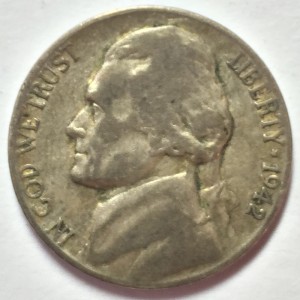
1942-P Jefferson “War” Nickel obverse
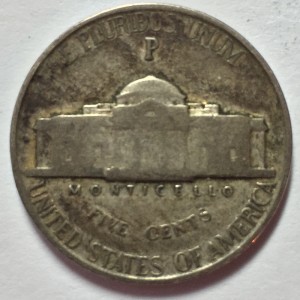
1942-P Jefferson “War” Nickel reverse
War nickels were struck by the U.S. Mint from mid-1942 through 1945 of an alloy that contained 56-percent copper, 35-percent silver, and 9-percent manganese. Removing the nickel and reducing the amount of copper used in these coins helped save these metals so that they can be used to produce military supplies. One specific need was the copper that went into the brass alloy used to produce bullets.
Looking at the coin and various grading images, if I sent it to a third-party grading service to be graded, it would probably be returned as a VG-8 since it has a little more definition than a flatter G-4. It could be argued that since the rims are more defined that it could be closer to a VG-10, but I would not represent this coin at that grade—besides, it is not for sale! Given that, what kind of profit did I made over the 5-cents face value.
According to the NumisMedia Price Guide, the current value of a 1942-P war nickel in VG-8 condition is $1.01. That is a 96-cent profit!
But what about the silver value? As I type this, Coinflation reports that the metal value of the coin (at the time writing this) is 85-cents with the silver value of 84-cents. That price is based on 0.0563 troy ounces of silver with the current price of silver at $14.88 per troy ounce.
Either way, I made a small profit on the coin and will add it to my hoard of interesting pocket change finds.
May 12, 2014 | base metals, cents, coins, nickels, RCM, Royal Mint, US Mint
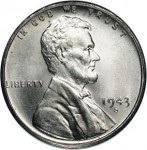
U.S. cents have been made of copper, steel, and copper plated zinc. What’s next?
Although the U.S. Mint does not define who they consider stakeholders but does mention the “coin industry” in one paragraph, the guideline questions are clearly targeted to the coin-operated machine industry. Coin-op machines are more than the soda and candy machines that may be in the break room where you work. These machines include toll booth machines, machines that produce bus and/or train fare cards, parking meters, game machines, and even the few pay telephones that are still in use. Everything that accepts coins will have to be replaced, repaired, adjusted, or scrapped should there be a change in coinage metals.
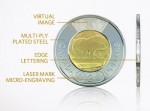
The new technology used by the Royal Canadian Mint to protect the Toonie (C$2)
In the United Kingdom, the Bank of England and law enforcement is engaged in a difficult fight against counterfeit £1 coins. Sources estimate that between 3-percent of the £1 coins in circulation are fake amounting to more than 45 million counterfeit coins. These fakes are so convincing and very well constructed that they can be successfully used in vending machines for payment including in London’s Underground. In an attempt to stem the problem, the Royal Mint has designed a new £1 coin to be circulated by 2017 in hopes to cut the counterfeiting rate.

New edge view of the coin the Royal Mint hopes will be able to thwart counterfeiters.
The coin-operated businesses in Britain are beginning to complain about the changes even though they are being given nearly three years to adjust. For their systems, the new coins will have a different weight, specific gravity, and the electromagnetic signature will differ from the current coin. Every system from the Underground to parking systems to food and beverage vending machines will have to be upgraded to accept the new coins. One report estimates that it will cost up to £50 million (approximately $82.3 million) just to update parking systems.
The Automatic Vending Association, the U.K.’s vending industry trade group, estimates that the new coin will costs its members over £100 million ($168.5 million) to convert their machines.
Expect the costs in the United States to be much higher mainly because of scale. The National Automatic Merchandising Association (NAMA), the $45 billion per year vending industry trade association in the United States, has already issued a report saying that it will cost from $100 to $500 per machine to convert them to accept new coinage.
The American Amusement Machine Association (AAMA) has come out against any change in U.S. coinage. It was reported that AAMA president John Schultz said to leave the coinage alone “because it works, rather than risk the costly consequences.” AAMA has not provided an estimate for those costly consequences.
The last significant change in coinage composition was in 2000 on the introduction of the Sacagawea “Golden” dollar coin. Following the debacle of the Susan B. Anthony small dollar coin that was mistaken for a quarter, the coin was redesigned without a reeded edge and given a golden color by adding manganese to the metals mix. Although this change primarily impacted the gaming industry that relied on the dollar coin, the vending machine industry did respond by converting old machines and manufacturing new ones that accepted the new coin.

The change to copper-coated zinc cents created a seven coin set for 1982
Any discussion of coin composition changes has to include the change from silver to clad coinage. When President Lyndon B. Johnson signed the Coinage Act of 1965 (Pub. L. 89-81) into law on July 23, 1965, the composition of the dime and quarter dollar was change from 90-percent silver and 10-copper to 75-percent copper and 25-percent nickel bonded to a core of pure copper. This mix of metals was selected so that the coins would have an electromagnetic signature that was very similar to their silver counterparts. The half-dollar was reduced to 40-percent silver surrounding a pure copper core.
This change in coinage was done for the same reason that congress has asked the U.S. Mint to study alternative metals: the cost of materials and labor to make the coins is higher than the face value of the coin. As of the Fiscal Year 2013 (October 2012-September 2013) Annual Report, it costs the U.S. Mint 1.83 cents in labor and materials to manufacture the one cent coin and 9.41 cents for the five cents coin.
As a comparison, the cost for the dime including labor and materials is 4.56 cents per coin while the quarter dollar costs 10.5 cents to make.
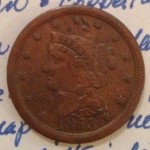
1853 Braided Hair Half Cent Obverse – The last lowest denomination coin eliminated by the congress.
- Does the U.S. eliminate the one cent coin?
- Does the U.S. eliminate the one dollar note in favor of a coin?
- If a transition to new metals is approved, does the government provide economic assistance to small businesses and sectors that will feel a bigger impact from this change?
- Will the federal government provide assistance to communities to help convert municipal services to be able to take the new coins?
- Should the U.S. Mint, a government agency, be allowed and/or required to earn a profit from its operations?
- How will the people be educated on the new coinage?
- What role will the Federal Reserve play?
Since the U.S. Mint did not define who their stakeholders are, it is fair to say that the stakeholders are all citizens of the United States. If you would like to comment, the U.S. Mint is looking for input on the following factors:
Costs to convert to circulating coins composed of alternative metals given the following possible changes to coins:
- Weight
- Electromagnetic signature
- Visual changes, such as color and relief
Transition time needed to introduce a circulating coin composed of an alternative metal.
Comments on how best to inform and educate both affected industries and the public on changes to circulating coins.
Environmental impact from the use of circulating coins composed of alternative metals.
Other issues of importance not identified above.
When commenting, note that the U.S. Mint said it is not considering aluminum alloy metals.
Responses are due to the U.S. Mint 60-days following its printing in the Federal Register (April 10, 2014 making the due date June 9, 2014). Electronic comments can be sent to Coin.StakeholdersResponse@usmint.treas.gov. If you prefer to send your comments the traditional way, mail them to Coin Stakeholders Response, Office of Coin Studies, United States Mint, 801 9th Street NW., Washington, DC 20220.
If you do comment and would like to share what you said with the rest of the community, either send it to me via email or post it as a comment below.
Photo credits: All photographs are the author’s except the image of the Toonie from the Royal Canadian Mint and the One-pound coin prototype from the Royal Mint.
Mar 5, 2014 | base metals, cents, coins, copper, news, nickels, pocket change, US Mint

U.S. cents have been made of copper, steel, and copper plated zinc. What’s next?
According to the budget report [PDF], it says:
The production and circulation of currency in the United States have been largely unchanged for decades, despite the growth in electronic financial transactions. Treasury is undertaking a comprehensive review of U.S. currency, including a review of both the production and use of coins, in order to efficiently promote commerce in the 21st Century. These studies will analyze alternative metals, the United States Mint facilities, and consumer behavior and preferences, and will result in the development of alternative options for the penny and the nickel.
Some of this has been ongoing for the last few years. As part of the Coin Modernization, Oversight, and Continuity Act of 2010, (Public Law 111-302 [PDF]), the U.S. Mint performed and Alternatives Metals study that was completed in August 2012 and then reported to Congress in December 2012.
The problem with the study is the politics written into the law which the report addresses in the executive summary. Key to the problem is the provision written into the law that gives too much consideration to the vending and coin-operated industry. Rather than find the best metals possible while considering the factors that would have to be changed to make new coins work in devices like vending machines, parking meters, and other machines that take coins for payment, the law is written as if the vending industry has veto power over the choices.
Reading the alternative metals report is like taking a college course in metallurgy. When reading the report, it is apparent that there is no perfect solution. Either the coin sizes and weights will have to change in order to meet electromagnetic signature (EMS) requirements to make new coins similar enough to provoke fewer changes to existing equipment or the EMS of the coins will have to change and the machines reprogrammed. In either case, something will have to change.
In short, the EMS is the waveforms that are sensed when a coin is exposed to low frequency radiation (harmless to humans). The waveforms are read by sensors and compared with a programmed baseline to verify that you dropped a real coin into the machine and not a slug.
As part of the alternative metal study, the U.S. Mint is holding a stakeholders meeting. Interested members of businesses, industries, and agencies will meet with the U.S. Mint study group to share their perspectives on the impacts of alternative metal compositions on circulating coins. This meeting will be held Thursday, March 13, 2014, from 10:30 a.m. to 3:30 p.m. (EDT) at the U.S. Mint Headquarters located at 801 Ninth Street NW, Washington, D.C., 2nd floor. Attendance is by invitation only. Anyone interested in attending can contact Leslie Schwager, Office of Coin Studies at OfficeofCoinStudies@usmint.treas.gov, or by calling 202–354–6600 no later than Monday, March 10, 2014 to request an invitation and obtain additional meeting information.
You can read the full announcement about this meeting in the Federal Register 79 F.R. 6672. [PDF]
Because of the recent storms and closing of the federal government, my work requirements have shifted making it difficult for me to attend. Anyone who will attend this meeting is invited to contact me. I would be interested in hearing all perspectives about the meeting.
Given the political nature of both the budget process and the law behind the alternative metals study, it is reasonable to believe that nothing will be accomplished by the president’s budget recommendation or the meeting at the U.S. Mint. In fact, since congress has to approve any changes to U.S. coinage and that this congress has been the least productive in history, do not expect change in your pocket change any time soon.







 → Read more at
→ Read more at 































